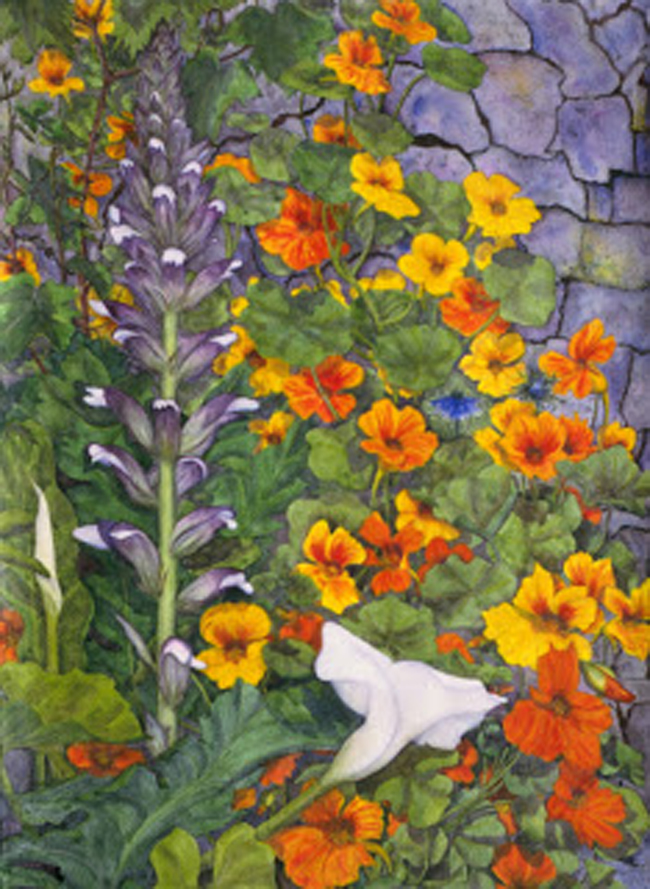Western Australian artist, Philippa Nikulinsky, is not only a superb botanical artist, but allies science, dedicated field observations and enormous skill to a passion for celebrating all the ecosystems of Western Australia. Her long years of art-making allow her to record the ever-changing landscapes, flora and fauna in a fashion that goes beyond environmental issues and political concerns, ultimately to achieve an incredible body of beautiful work that enriches Australia.
Read Moreflower paintings
Art and Gardening /
Garden designers and gardeners have always recognised the role that design and art play in the formation of a garden, even - in some cases - a vegetable garden. The Royal Horticultural Society's Lindley Library (www.rhs.org.uk/learning/library/) is a wonderful collection of wisdom on gardening, its history and garden design. But any of us can have a great deal of fun in a garden when we regard it as a living canvas for our art.
Just as a painting has to be organised, so does a garden. Both really need structural "bones", an underlying structure on which to clad the later work of colour. Trees, foundation shrubs, permanent structures likes pergolas, columns or stone walls, all fall into this category. In the same way, it is often very rewarding to put down a totally abstract, strong under painting on canvas before you start on any image painting. For both garden or painting, it is really about creating an experience. John Dewey described in Art as Experience, "The artist selected, simplified, clarified, abridged and condensed according to his interest". Just as you plan a painting that excites, challenges and stimulates or soothes, calms and welcomes, so you can design a garden that elicits a host of reactions from anyone viewing it. Large or small, every garden soon has its own character and atmosphere.
Only after the initial underlying structure stage of creation can colour be added with success. On a canvas, yes, it is of course paint. In the garden, it is a bewildering array of plants which offer varying colour and shapes from leaves or flowers, annual or perennial, seasonality and size requirements.... all dependent on the micro and macro-climate you have. In other words, endless choices and fun. Nonetheless, in the garden, just as in a painting or drawing, the fewer the elements involved, the stronger they have to be from a visual point of view.
Gardening is in some ways more like some disciplines of contemporary art - the garden does not have to endure for a great length of time, given that you can use annuals or you know that everything will change as the seasons turn. But gardens, ideally, do share a longer term aspect of more traditional art - the trees and shrubs can potentially last for centuries, as an artist hopes his or her work on canvas, paper, clay, etc. will do....
Climbing the Wall, Palma, watercolour, Jeannine Cook artist
Whichever the creation, painting or garden, it can be the source of interest, pleasure and delight to innumerable other people. That compensates for the hours of planning and hard labour that have gone into the work... but at least in painting, you seldom get blisters!
Catching up with spring /
Spring in coastal Georgia comes with such a rush of beauty and imperatives that there is never enough time to celebrate it all. Suddenly there are a myriad subjects to draw in silverpoint, another vast selection to paint in watercolours - and time never suffices.
Azalea trio, silverpoint, Jeanninie Cook artist
It is always interesting to return to a subject that one has drawn or painted before; every artist has favourite themes to visit and revisit over time. It is astonishing how a simple flower, such as an azalea, can elicit different reactions and dictate different approaches every time it is drawn or painted. No wonder museums have such diverse collections of paintings and drawings which include and celebrate flowers. Think of the heyday of Dutch flower painting in the 17th century, when so many talented artists followed Jacques de Gheyn II's example. He was one of the earliest artists (1565-1629), who depicted wonderful tulips, roses and other flowers (not all of which bloomed at the same time) to satisfy the demands of the ever-more wealthy Dutch burghers. Since then, Manet, Fatin-Latour, Monet, Renoir, Matisse and so many others have turned to flowers for inspiration again and again.
Perhaps it is because one can see in a flower the basis for realism or pure abstraction - at the same time, really - that it is endlessly interesting as a subject. Added to which, I personally find a serenity and elegant logic to a flower that delight. However, each time, there is a surprise in how the structure works and I am often reminded of Paul Valery's statement: "Until you draw an object, you realise that you have never actually seen it." And so one rushes to catch the fleeting spring glories, to try and "see" them close up and celebrate them - again!

